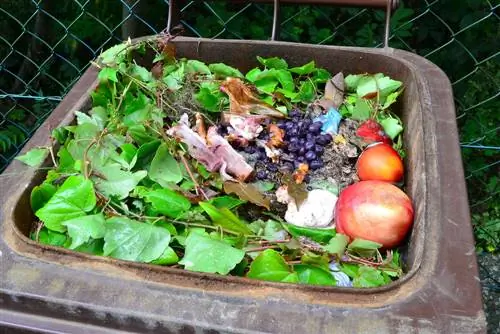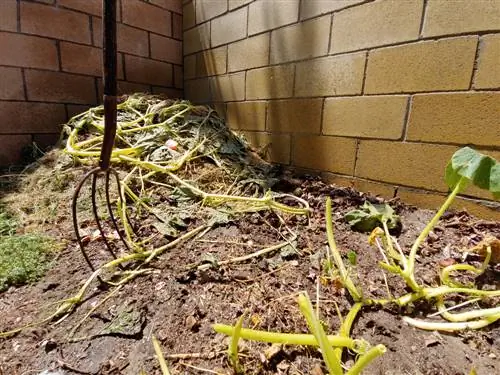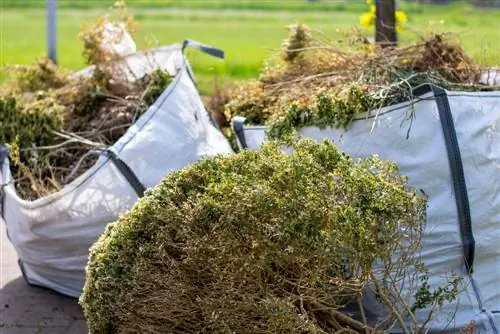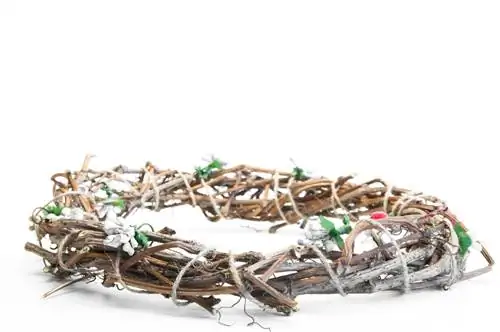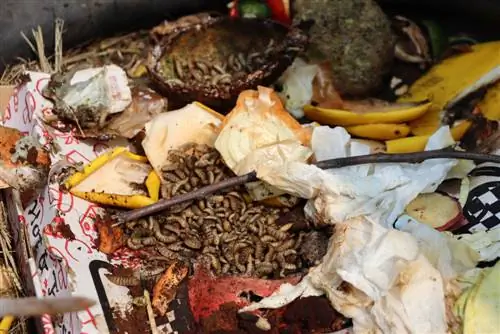- Author admin [email protected].
- Public 2023-12-16 16:46.
- Last modified 2025-06-01 06:02.
What goes into the organic waste? Which container is correct? How can you get rid of maggots in organic waste? This guide will not leave you alone with important questions about competent waste disposal. Read practical and comprehensible answers here. How to dispose of organic waste correctly.
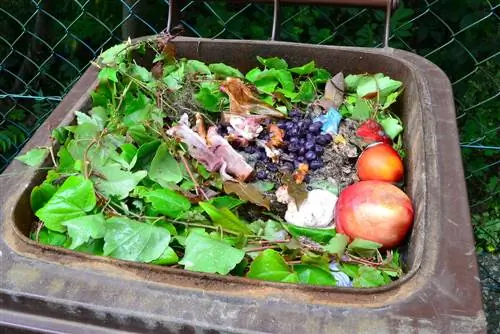
What belongs in organic waste and how do you get rid of maggots in it?
Organic waste includes organic waste from the kitchen and garden that is recycled by microorganisms. Organic waste includes leftover food, fruit peels, vegetable scraps and garden waste. To combat maggots in organic waste, home remedies such as vinegar water, table s alt, pepper and oxygen bleach help.
- Organic waste is organic waste that is recycled in composting and biodigestion plants using microorganisms to produce natural fertilizer or biogas.
- Organic waste includes leftover food, fruit peels, garden waste and other organic substances that decompose.
- Home remedies for combating maggots in organic waste include vinegar water, table s alt, pepper and oxygen bleach.
What is organic waste?
Organic waste is organic waste from the kitchen or garden. In this waste, soil-based organisms, microorganisms and enzymes are active to decompose the organic matter for recycling in the natural cycle. In this way, valuable humus, nutrient-rich compost or natural biogas is created from organic waste. Biowaste therefore represents a valuable resource for the environment and plant care.
What is allowed in the organic waste - what is not?
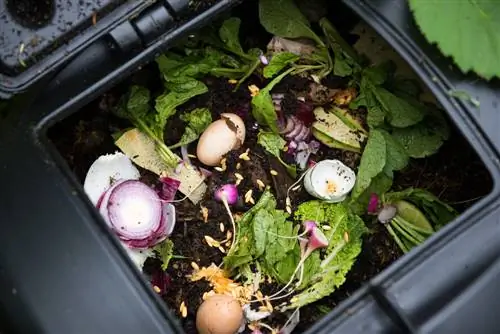
Only biodegradable items should be disposed of with organic waste
Biogenic waste can only be processed properly if there are no inorganic foreign substances in it. For this reason, every household in Germany has been able to separate waste since 2015. Many municipalities provide separate organic bins for this purpose, in addition to the residual waste bin. The following table gives an overview of what is allowed in organic waste and what is not:
| Allowed in | Not allowed in |
|---|---|
| Leftovers | Plastic |
| Meat/Bone | Dog poop/cat litter |
| Fruit bowls | Glass, metal, ceramic |
| Vegetable leftovers | Stickers |
| Grain products/bread | Ashes |
| expired food | Hygiene items |
| Coffee grounds/coffee filters/coffee pods | Cigarette butts |
| Tea bags/tea grounds | Cleaning rags |
| Garden waste | Vacuum cleaner bags |
| potting soil | Street sweepings |
| untreated wood | treated wood |
| Kitchen/newspaper paper | colorful printed paper |
| Hair, feathers | wallpapers |
| Small animal litter | Textiles |
| Wood wool, sawdust | Carpet |
Please note: This list is not binding. What actually belongs in your organic waste depends primarily on the recycling options available locally. The decisive factor is whether your municipality operates a composting plant or a biodigestion plant. To be really sure about the question “What goes into organic waste?”, please contact your local waste advice center. On the website abfallberatung.de you will find the contact details for currently 563 municipalities. The Nature Conservation Association of Germany (NABU) also offers a practical search mask by postal code so that you can quickly and easily contact your local waste advice center.
This is allowed in - further explanations
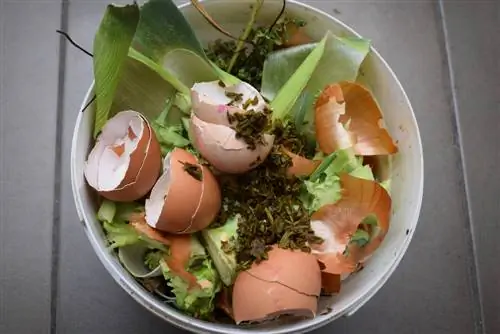
Eggshells are a blessing for the compost
In principle, all organic kitchen waste can be disposed of in an organic waste bin. It doesn't matter whether leftover food, meat and bones are raw or cooked. Cheese, cheese rind (natural rind) are also permitted, as are all kinds of dairy products, such as yoghurt or quark. However, milk must not be poured into the organic waste bin.
Citrus fruits also end up in organic waste, like orange peels or banana peels. Egg shells, mussel shells, nut shells and anything left over from cleaning vegetables are also permitted. All organic garden waste, including potting soil and wood as cuttings from trees and bushes, can go into the organic waste bin.
If paper is not colorfully printed, it is classified as organic waste. Newspaper, kitchen roll paper or egg cartons have the additional advantage of absorbing moisture as intermediate layers. For this reason, hair, feathers, wood wool, sawdust and small animal litter can also be safely disposed of with organic waste.
This is not allowed in - further explanations
Plastic of all kinds is not allowed in the organic waste bin. This also includes disposable tableware, Tupperware triangles, plastic shopping bags and food storage bags, even if they are declared biodegradable. Because glass, metal and ceramics do not decompose, organic waste bins are taboo for these materials. Materials that only decompose after many years do not go into organic waste, such as carpets, clothing, bandages, leather or wallpaper. Although expired food is classified as organic waste, this does not apply to expired medication.
Colourfully printed newspaper has no place in organic waste, nor does grease-repellent baking paper. This category includes glazed, varnished or otherwise treated wood, such as chipboard wood or WPC decking.
Excursus
Upcycle organic waste into natural fertilizer
Informed hobby gardeners do not simply throw organic waste from the kitchen and garden into the organic waste bin. When you create your own compost, fruit peels, vegetable scraps, plant leaves and uncooked food scraps are transformed into valuable natural fertilizer. Balcony gardeners reserve a partially shaded spot for a worm farm. In it, compost worms are constantly busy producing rich vermicompost and nutritious worm tea from kitchen waste for magnificent pot and box plants.
Correct organic waste containers - 2 tips for kitchen buckets and bags
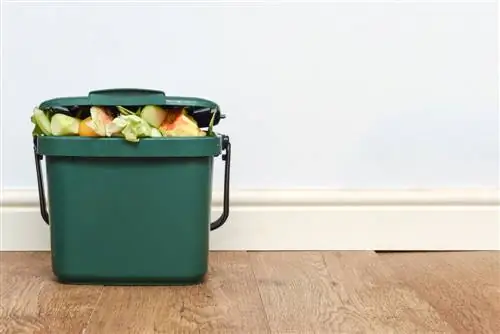
Organic waste buckets should not be too big and, if possible, should not carry a bag or one made of paper
The organic bin is provided by the municipality. How you collect the organic waste and put it in the bin is up to you. This is an unsavory, dirty and smelly undertaking, especially in summer. By following these two tips on trash cans and trash bags, you will have an easier time collecting organic waste:
Use a special organic trash can
Investing in a special organic waste kitchen bin is worth it because it saves you unpleasant side effects and makes it easier to empty it in the large organic waste bin outside. The following criteria are recommended:
- Size: small capacity with a maximum of 5 to 10 liters to avoid long storage in the kitchen
- Lid: lockable lid, ideally as a hinged lid with integrated bio-filter
- Emptying underside: additional, hidden handle on the bottom for emptying in the organic bin
An exemplary product example at an affordable price is the organic trash can from Obi (€31.00 on Amazon). The container has a safety locking device on the handle. The lid can only be opened when you tilt the ergonomic carrying handle backwards. This lid is only opened to fill in the organic waste. To empty the organic waste bin without contacting the contents, there is a handle on the bottom.
Paper bags instead of organic plastic bags
So-called “compostable” organic plastic bags are not suitable for organic waste. The material does not decompose or only partially decomposes during the approximately three weeks of fermentation and post-rotting. For this reason, the employees at the recycling plant laboriously and manually sort out organic plastic bags as contaminants in advance. Nevertheless, bags still end up in the composting facilities and affect the quality of the organic fertilizer produced. The solution to the problem is to use paper bags to collect organic waste in the kitchen.
Tip
The organic waste bin is a land of milk and honey for raccoons. It takes the clever omnivores just seconds to open the lid, plunder the contents and leave a smelly mess behind. With a lockable barrel lid you can put a stop to the furry rabble. A municipal organic waste bin can easily be retrofitted with the useful lid.
Dispose of organic waste correctly - how does it work?
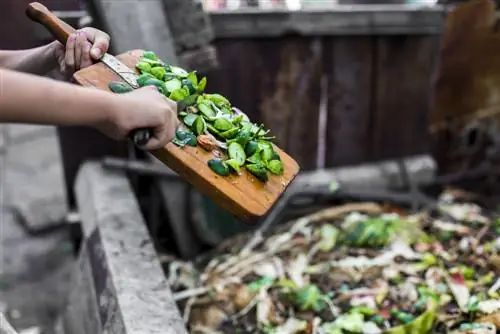
Larger organic waste should be shredded before throwing away
The separation of organic waste and residual waste is the first step on the way to the best possible disposal in harmony with nature. The second step depends on how you treat organic waste. The following tips show how to do it correctly regarding the permitted components in the table above:
- Leftover food, meat, bones: in normal household quantities, if necessary wrapped in kitchen paper or newspaper
- Fruit peels, vegetable scraps: no whole fruits, preferably chopped
- Grain products, bread: unpackaged, whole loaves of bread cut into small pieces
- expired food: without packaging
- Coffee grounds, coffee filters, coffee pods: let them dry first
- Garden waste, potting soil: picking up plants, cut flowers, crumbling compacted potting soil
- Wood, wood wool, sawdust, small animal litter: chop wood, loosen wood wool, sawdust
- Paper without color printing: use as a base cover, wrapping material or intermediate layer
Do you still have questions about competent organic waste disposal? Then please take a look at the following 5 questions and answers:
Throw organic waste into the bin without a bag - is that possible?
Throwing organic waste loosely into the bin is even recommended by environmentalists. Ideally, you should line the pre-sorting container in the kitchen with newspaper or kitchen paper and collect without a bag. Alternatively, use paper bags that you can later put in the large organic bin.
Can organic waste be disposed of in the residual waste?
If the organic bin is bursting at the seams, you can safely use the residual waste bin for organic waste. This measure is also advisable if the organic bin has already reached the maximum permitted weight and there is a risk that the organic waste will not be collected.
When will the organic waste be picked up?

In most communities, the organic waste bin is picked up once a week
The collection dates for organic waste vary seasonally. From spring to autumn, collection takes place weekly in most municipalities. If only a small volume of organic waste is generated in winter, it is emptied at intervals of 14 days. Every year, cities and municipalities publish a collection calendar with all important dates, precisely tailored to each street.
How can you dispose of organic waste yourself?
In most regions of Germany there is the option of handing in organic waste at recycling centers yourself. The recycling centers of the award-winning Berliner Stadtreinigung (BSR) are open almost every day to accept organic waste. There is usually a small fee for this service.
What happens to organic waste?
Organic waste is transported to the nearest composting or biodigestion plant. For composting, the waste is first pre-sorted and sieved. In the following rotting phase, high temperatures ensure accelerated decomposition and killing of germs. During several weeks of post-rotting, valuable humus is created, which is then prepared for the end consumer. A biodigestion plant converts organic waste into biogas at natural gas levels. Solid digestate is used as compost, liquid residue is used as liquid fertilizer in agriculture. This is done in an exemplary manner, for example, in the biogas plant of the Berliner Stadtreinigung (BSR)
Maggots in organic waste - what to do?

Maggots in organic waste arise when house flies and fruit flies lay their eggs in it. Within a short time, hordes of small worms hatch and the waste comes to life. Especially in the warm season, repellent worm infestations occur in the warm, humid microclimate of the organic bin. You can solve the problem with simple home remedies. This is how it works:
- Vinegar: Add 5 tablespoons of vinegar to 1 liter of water and spray on the maggot infestation with a spray bottle
- Saline: sprinkle on the worm-infested organic waste
- Pepper: Boil 4 tablespoons of pepper powder in 1 liter of water and use as a natural spray
- Bleach: Stir 2 tablespoons of bleach (oxygen bleach) into 1 liter of hot water and spray sparingly on maggots
If you get rid of the flies in organic waste, you can effectively prevent maggot infestation. With a special maggot lid for the organic bin, you can prevent nasty blowflies from entering. A bio-filter integrated into the lid prevents an unfiltered exchange of outside and inside air. Positive side effect: As a result of the improved microclimate, no mold can develop in organic waste.
Frequently asked questions
How should you store organic waste until it is picked up?
Moisture and heat are poison for organic waste. Mold and maggots spread explosively under these conditions. Do not dispose of wet organic waste in the organic waste bin. If necessary, wrap damp leftover food with newspaper or use paper bags. Ideally place the organic waste bin in a shady, cool location.
Why wasn't the organic waste picked up?
In many municipalities, city cleaning employees are instructed to take a look at the organic waste bin to check. If there is unauthorized residual waste in it, the bin and its contents remain standing. Remove the foreign matter and put the bin back on the street for the next collection date. In winter, organic waste can freeze in the bin and cannot be dumped. In this case, employees attach a notice to the container. Other reasons include a parked pickup point, exceeding the maximum weight or rescheduling due to a public holiday.
Which bags are suitable for organic waste?
If you want to collect organic waste in bags, the only option is paper bags. Plastic bags are just as suitable as so-called compostable organic plastic bags. Although the latter decompose sooner or later, this process takes far too long to be recycled in a composting plant or fermented into biogas. Furthermore, biodegradable material breaks down into water, carbon dioxide and minerals and does not turn into humus.
Tip
An organic waste bin in the front yard is definitely not a feast for the eyes. With simple means you can hide the location of the container from prying eyes and shade it at the same time. Decorative privacy plants form a green wall around the parking space. Ideal candidates are evergreen deciduous shrubs such as easy-care cherry laurel (Prunus laurocerasus) and elegant boxwood (Buxus sempervirens). The shortlist includes conifers that tolerate cutting, such as arborvitae (Thuja) or yew (Taxus baccata), as well as head-high ornamental grasses, such as bamboo (Fargesia murielae).

